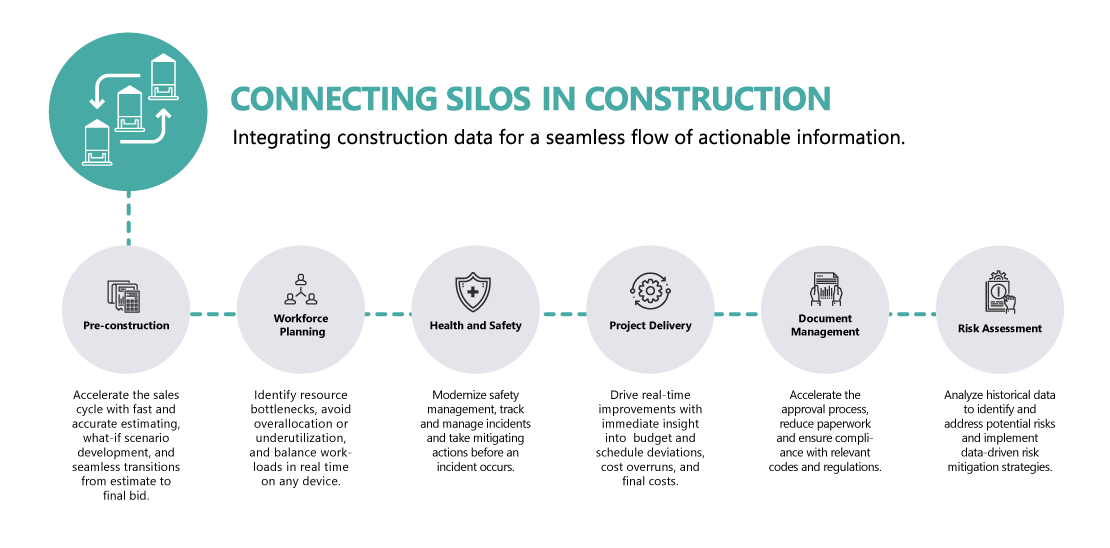

Building a Modern Data Infrastructure in Construction: Unifying Project Data for Efficiency and Innovation
Explore modern data solutions for AEC companies. Learn about data management, compliance, and AI insights in the construction industry.
Download the EbookWith high risk and low margins, the call for using digital technologies in construction has never been louder. Leading firms are investing heavily in integrated systems to manage projects effectively and centralize project data to keep projects on track. They’re also taking advantage of better ways to improve collaboration between all stakeholders, sharing real-time data and applications so all project participants have the information they need when and where they need it.
A key factor in doing all this successfully is accurate, unified project data across a company’s ecosystem of applications. It can’t be done unless trusted data from your entire application footprint is being collected integrated and analyzed seamlessly.
Connecting silos across the project lifecycle
Here’s the challenge: construction projects involve a multitude of specialized systems each with its own set of data, both inside your company and outside, causing the data to become siloed or isolated. To remove data silos, you need to identify them, and that can be hard because teams often function as autonomous units within a company, making data silos hard to detect.
In addition, data can’t easily be passed between departments without proper technology. Excel, paper-based processes don’t cut it anymore. Companies need high-quality tools and applications that can handle quick transfers of information and referential information like shared project, vendor, and customer numbers.

5 ways unified data improves the lifecycle
1. Sales enablement
Early on during planning and pre-construction stages of a project, salespeople, estimators, and project management all need to understand what is being sold at what price and at what risk. When it’s clear how bids have evolved and why, the organization can account for the unknown confidently and logically.
With integrated CRM, bid and estimation systems, you can track opportunities and bid lists through the various sales stages. As the opportunity advances, workflows and centralized document management make it easier for teams to contribute to and review RFPs, RFIs, and RFQs and track submittals so nothing falls through the cracks. Each system has a role to play, and integration makes the process more seamless between them all.
2. Optimized resourcing
It’s common for field and office resources to struggle sharing key information in a timely manner while keeping track of scheduling and project details. For many superintendents, paper tablets or spreadsheets have served as the only way to manage project scheduling and assignments—and for some it still is. Often contractual schedules are not aligned with what is actually happening on the jobsites. But more and more, we’ve seen companies turn to integrated project planning technology and mobile solutions to bring efficiency and actionable analytics to workforce planning. This could be comparing to the baseline contractual schedule or flattening out the labor peaks and valleys. It’s all about the awareness of what is coming. These solutions remove many of the manual processes that have been used for decades, and can identify resource bottlenecks, avoid overallocation or underutilization, and balance workloads.
By 2025, 45% of large enterprises with hourly-paid workers and variable demand for labor will use automation to drive workforce scheduling decisions.
Gartner Market Guide for Workforce Management Applications
3. Accelerated project delivery
In addition to keeping projects and personnel on track, project management and field supervision staff are the ones collecting, managing, and analyzing data each week. In our discussions with industry leaders, they indicate that when in the field, many project managers are required to make quick decisions with increasing frequency, often without guidance from others. For example, project managers and supervisors are often asked to verify that projects can be completed within budget. With easy-to-use dashboards on a mobile device, project managers can have forecasting data at their fingertips, and provide immediate answers about budget and schedule deviations, cost overruns, and final costs. Issues can be quickly pinpointed, course-corrected, driving real-time efficiency during the project delivery phase
Construction companies are realizing the benefits of efficient data management, with 43% saying they would make better decisions if they had greater access to real time and historic information on project performance.
Significant digital transformation underway, Bloomberg.com
4. Improved productivity, collaboration
We often hear how difficult it is to collaborate on project documents with external stakeholders— architects, engineers, subcontractors and more. Everyone wants a “single version of the truth” for every document, as well as a streamlined way to manage change requests for all upstream and downstream documents. They want to be able to automatically send and update plans, contracts, or blueprints, and link RFIs and submittals back to initial drawings for reference.
Leading companies are using digital document repositories to upload blueprints, certifications and other documents, track changes to them, and record all decisions made to the content. Instead of calling or visiting the office, project information can be accessed via a portal, minimizing miscommunication and strengthening coordination among team members for smoother project execution.
5. Streamlined, transparent financial data
Financial information like budgets, contracts, change orders, and invoices are updated instantly instead of at the end of the week or month. Relying on intermittent and delayed updates is risky. Without streamlining project and finance systems, accounting teams are left guessing on forecasting and budget. When these systems are integrated, project teams can make budgeting and forecasting decisions based on actuals from the accounting team. Both sides are empowered to make knowledgeable decisions, streamline change management, and accurately monitor the financial health of a project.
It’s about accurate data
Accurate, unified data is the first step in any digital transformation project. Once everyone trusts the data, planning and project decisions can be made more confidently. It’s why the best decisions are the ones that are data-driven, and the larger the project, the more important data becomes.
Integration allows data from one application to automatically populate essential fields in the other software, removing the need and risk of errors associated with entering the same data into more than one place. If you’re manually dissecting spreadsheet data, you run the increased risk of overlooking valuable information and making mistakes.
But you can only make sense of your data and make intelligent decisions based on that data if it’s collected in a strategic manner, housed in a central system, and accessible to those who need it. We use Microsoft Azure cloud as the foundation for our construction solutions, it’s a state-of-the-art data platform that can bring in data from both internal and external sources, align it, centralize it and apply intelligence so you can spend your time taking action instead of collecting and parsing data.
Bring in the AI
When we talk about getting the most out of construction data with AI and predictive analytics, it all pivots on Azure, which uses machine learning and large language models to detect patterns and make predictions. And now, Microsoft is going one step further integrating AI throughout its operational applications using CoPilot so companies can make better and faster decisions.
Imagine the actionable analyses AI could drive in the construction industry:
- Analyzing project data, historical records, and risk factors to identify potential risks and assess their impact on project delivery.
- Providing risk scoring, recommendations for mitigation strategies, and real-time alerts to project managers, enabling proactive risk management.
- Analyzing resource availability, skills, and project demands to predict future resource needs and identify potential bottlenecks, such as overutilization and underutilization.
92% of construction companies intend to use AI, but readiness is a challenge. We can help you get your data in shape to harness AI’s full potential.
Dashboards provide customized visibility
Once you’ve got the data and predictions, dashboards can provide insights from across applications, blended datasets and KPIs for schedules, costs, risks, and more — a real-time summary of detailed performance data to inform current decision making.
Dashboards clear the clutter because you can see the analysis of all your data sources in one window, and on any device. For example, construction dashboards allow you to immediately spot the contract value, margin, budget, and a number of critical indicators that help monitor current status and successfully deliver a project.
At Hitachi Solutions, we’ve developed a ‘single-pane-of-glass’ solution that provides wide-ranging, yet cohesive information you can rely on— everything from safety incident reporting, to change order analysis to resource utilization. The dashboard below is an example, but could be customized to include any specific project control metrics you need.

Low code is a great place to start
When beginning a data unification project, consider starting with easy wins using low-code application technology, developed on the Microsoft Power Platform and tailored for the construction industry by Hitachi Solutions. Low-code Power Platform applications and workflows can be quickly integrated into your existing construction application footprint so you start seeing immediate value in your project operations.
One ideal application for low code is safety management and reporting as many construction companies are looking to modernize their approach. With Microsoft Power Apps, we’ve created easy-to-use solutions — all available via tablet or phone — that enable safer, more streamlined experiences for employees, contractors, and customers.
Here are some examples:
- Gated site arrival and task-based risk assessment
- Incident logging including mobile camera and time stamp integration
- Work completion entry and tracking via subcontractor portal
- Streamlined permit-to-work management
- Integrated incident and near-miss reporting
How we can help
Given the distributed nature of construction project management, it’s unreasonable to expect a one-size-fits-all approach to technology will fit everyone. New technologies deliver the greatest value when they seamlessly integrate with existing enterprise systems. We recognize that a company may have already made an investment in a point solution, or may prefer to use different functionality to enable a specific area of their business. Our focus is on ensuring companies are working with accurate, unified data. Then you can integrate all the pieces to deliver solutions that require minimal deployment effort, seamless user experience and a superior cost-benefit advantage.
For over a decade, Hitachi Solutions has been working with construction organizations around the world to enhance their technological infrastructures. We can find a solution to help turn your project inefficiencies and expenses into opportunities for growth, increased cost savings and rising productivity.
Contact us today to learn more about our construction solutions built on the Microsoft platform.


